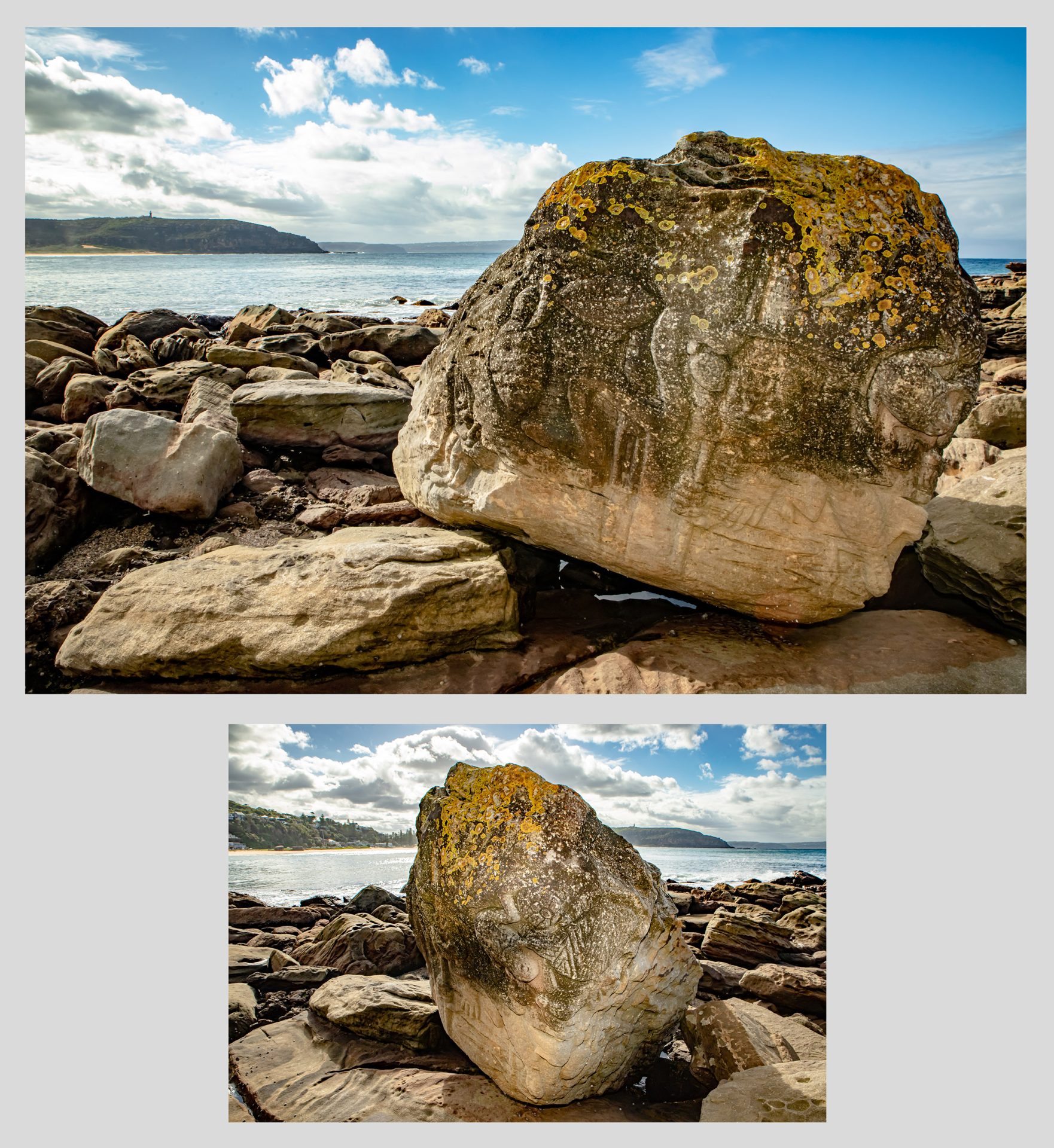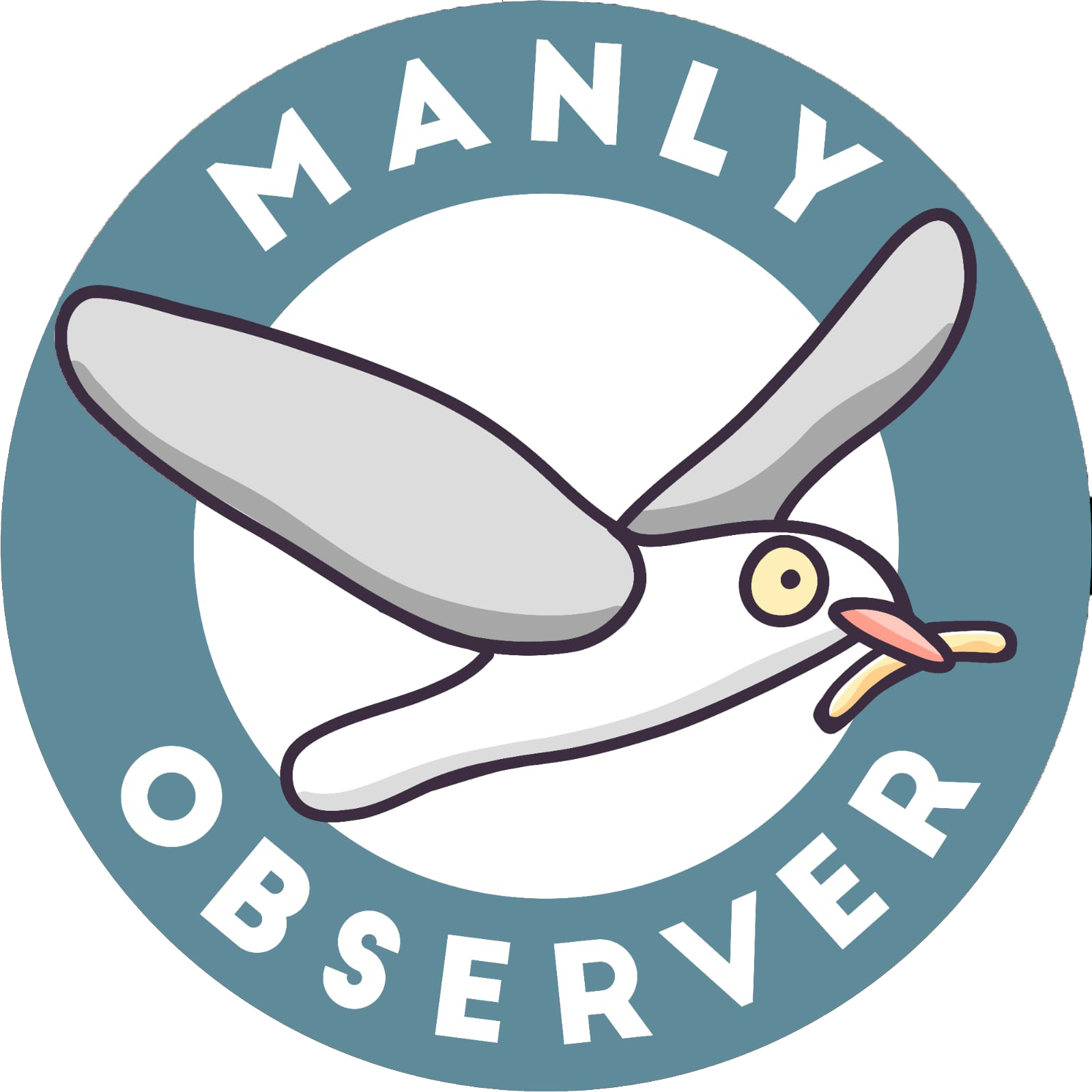Since the 1970s, a mysterious character operated anonymously carving curious creations in rocks all over the Northern Beaches’ peninsula. I have spent the last year hunting down his hidden works in our bushland.
Who is the Phantom Carver?
I found evidence of his activities from Palm Beach, in the north, to the Quarantine Station, in the south, and west to Clontarf, although much of it has been lost, reclaimed by nature. He has left behind an eclectic collection of engravings of people and animals in often strange and remote locations.
On 19 September 2018, during clearance work to remove invasive weeds on the headland south of Freshwater Beach, bush regenerators revealed a large hidden carving of an Aboriginal face. If the engraving was smothered by native plants, the face may have remained hidden for decades, perhaps never to re-emerge.
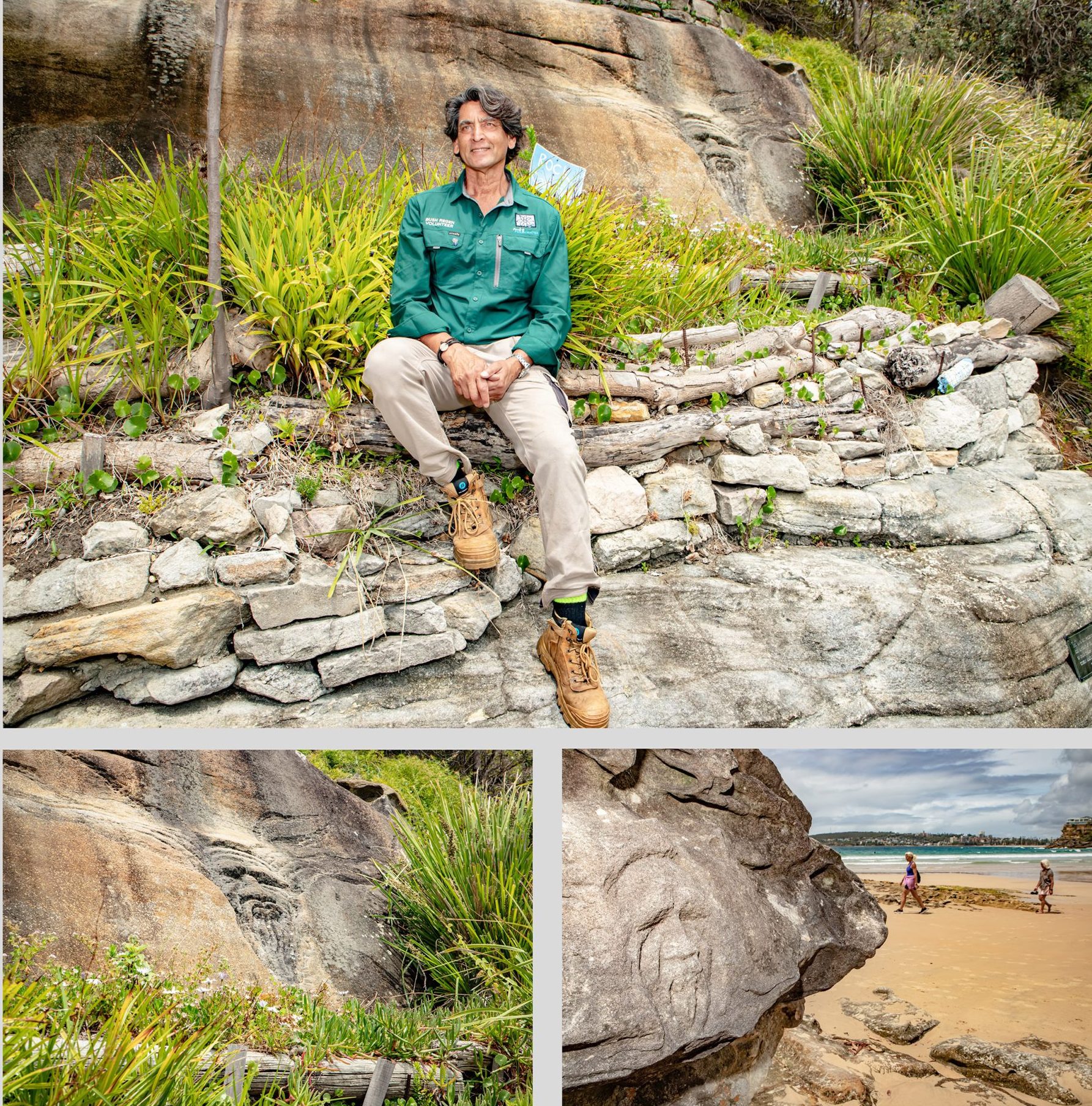
Below: the face + another engraving on the north end of Freshwater Beach. Photos: Alec Smart
Denver Beven, a 2024 Northern Beaches Citizen of the Year, revealed to Manly Observer that he was the one who rediscovered the camouflaged façade on the newly renamed Irene Crump Reserve.
“I made the startling discovery after abseiling down a cliff face to clear invasive lantana and other weeds smothering a rock,” he recalled.
“At first I thought it was a historic Aboriginal engraving, then we learned it was a piece by the notorious Phantom Carver.”
“At first I thought it was a historic Aboriginal engraving, then we learned it was a piece by the notorious Phantom Carver.”
“It was apparently done by a local stone mason, Mick Leslie, in the 1970s, who was known as the ‘Phantom Carver’. Ironically, he was employed by Warringah Council at the time, but this was an unapproved after-hours hobby,” remarked members of the Friends of Freshwater page in a post. This stonemason had also secretly done other animal carvings on the northern pathway at Freshwater Beach. The 1880 carvings on Queenscliff Steps were also done by him. He is part of Freshwater folklore but not everyone is convinced of the artistic merits of his works.”
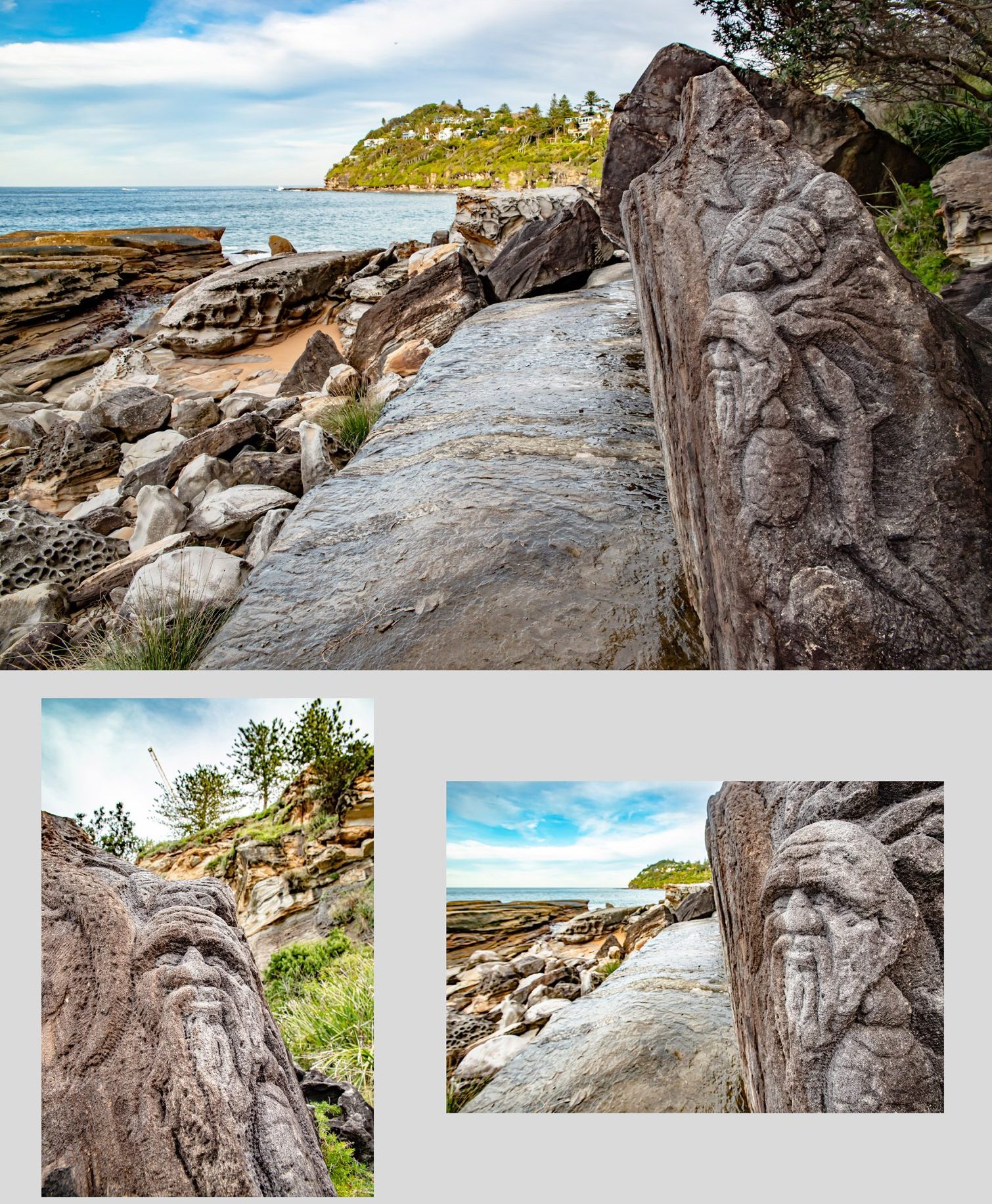
Cheeky chiseller
So who was this cheeky chiseller with the mysterious moniker? Mick Leslie created dozens of public artworks during his lifetime, most around shorelines.
Visitors to the North Head Quarantine Station, Freshwater, Long Reef, North Curl Curl, Narrabeen Lagoon, Mona Vale Basin, Winnereremy Reserve, Newport, Bayview, Ingleside, Bilgola, Whale Beach, Palm Beach, and countless other sites may already be familiar with Mick’s public artworks, even if they weren’t aware of who made them.
Some of them are large stone statues commissioned by the former Warringah and Pittwater Councils, for whom Mick created a lot of sculptures. The Easter Island head beside Bayview Baths is one example. Several of the large sculptures in the children’s play area of Bilarong Reserve, beside Narrabeen Lagoon, are also his.
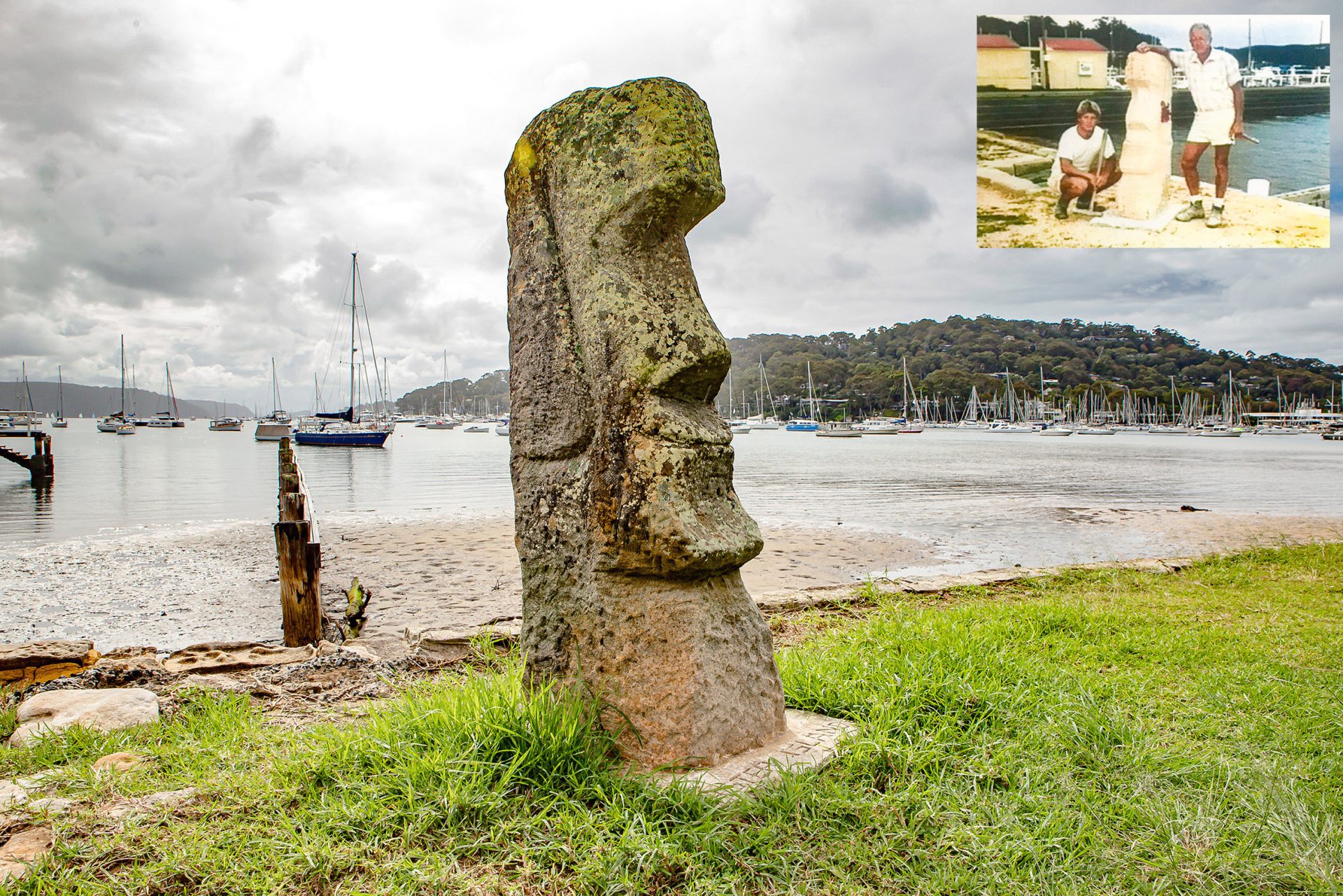
The latter were undertaken with two other local stonemasons, Chris Bennetts and Newton Bishop (whom Northern Beaches Council commissioned in 2024 to carve the Midget Farrelly tribute on Palm Beach).
But the majority of the engravings are little whittles in shoreline rock faces – Aboriginal faces and lizards a recurring theme – that pay homage to Indigenous Australians, our unique culture and native wildlife.
Newton, who has undertaken a varied collection of stonework all over NSW, including the new retaining walls to hold back high tidal surges on Collaroy Beach, and sculptures in Berry Reserve playground in Narrabeen, described Mick as a mentor.

Skilful sculptures
“I started working with another sculptor artist called Chris Bennetts, and that was in the early 90s,” Newton said.
“He introduced me to Mick, because Mick used to come around most weekends and they used to work together in Chris’ yard. Chris actually had a commercial business called Ishi Buki Garden Art. Mick would come by a lot and do carvings on site or he’d bring carvings in.
“We’d see him at least once a fortnight. He’d come in and do amazing art. He had a creative, inquiring mind. He’d always have a sketch or a drawing or a painting and little sculptures he’d sell.
“Mick worked with Pittwater Council in the 80s. 1988 was the Bicentennial year and the councils [Manly, Warringah and Pittwater] had a huge amount of money to spend on the coastal walks along the Northern Beaches,” he continued.
“From Manly to Palm Beach, they were trying to design a walkway to go all the way through. They had a massive amount of stonework created along the route and Mick made a lot of sculptures, including Long Reef, Bilgola, Turimetta, Narrabeen, Warriewood.”
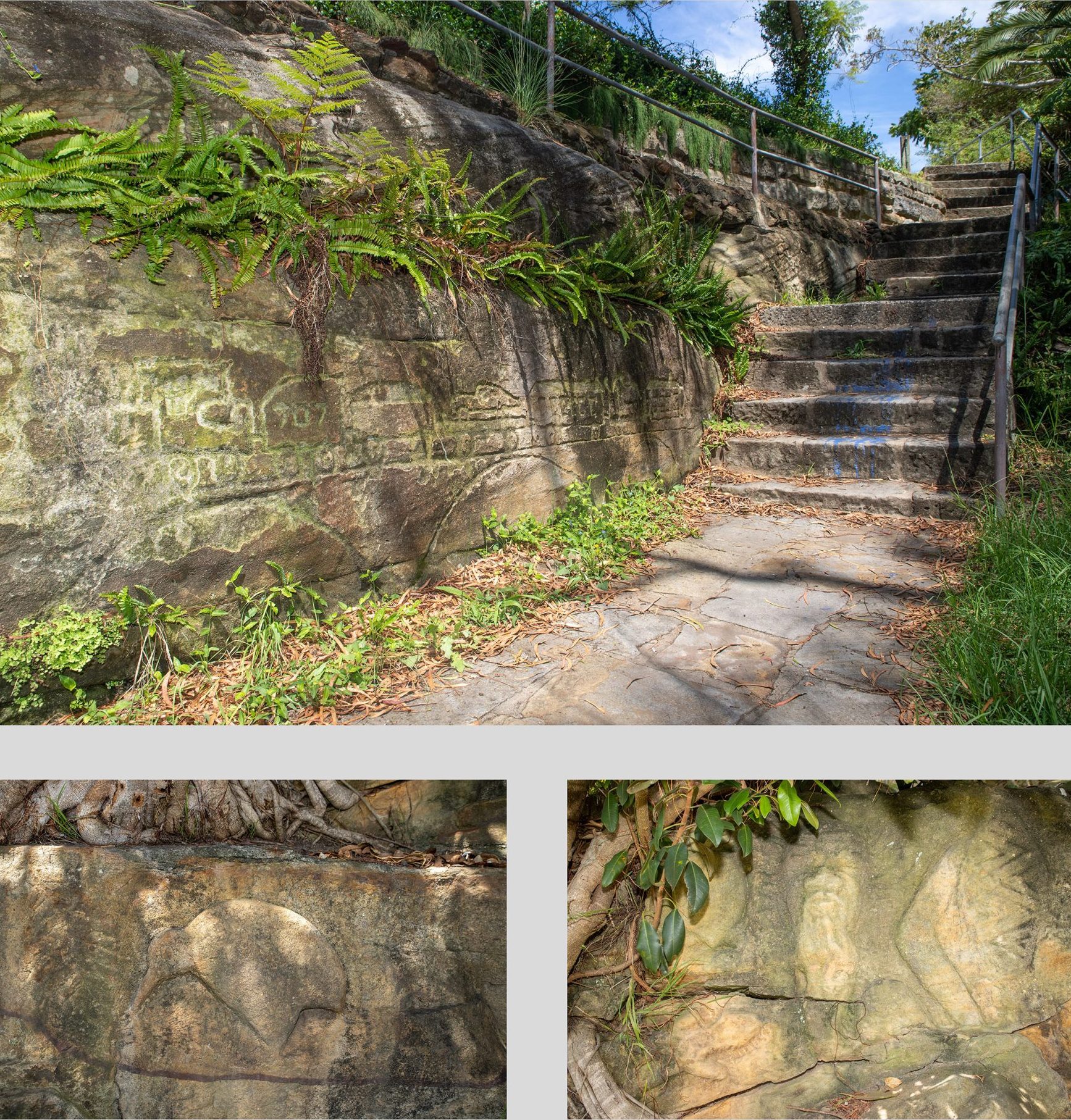
Below, a Kiwi and an Aboriginal face on the same wall. Photos: Alec Smart
And further afield?
“At Winnereremy Bay, he made the King Neptune. He also did Bilarong Playground at Narrabeen with us [Chris and Newton, all three sculptors working alongside]. I think he did another Neptune there, and a pillar, with all the fish. He did an owl, and, oh heaps, actually!” he added.
Anonymous engraver
How did Mick transition from a stonemason working for the councils, sometimes selling his home-made sculptures, to the infamous Phantom Carver?
“In his own time (and sometimes in work time!), he’d be in the midst of creating something, then he’d run around the corner and find a rock shelf, and carve a face or a little lizard or anything that came into his mind,” Newton revealed.
“People would see it and say, ‘Oh look, who did that? Wow!’ He loved being anonymous, and the name ‘Phantom Carver’ stuck.”
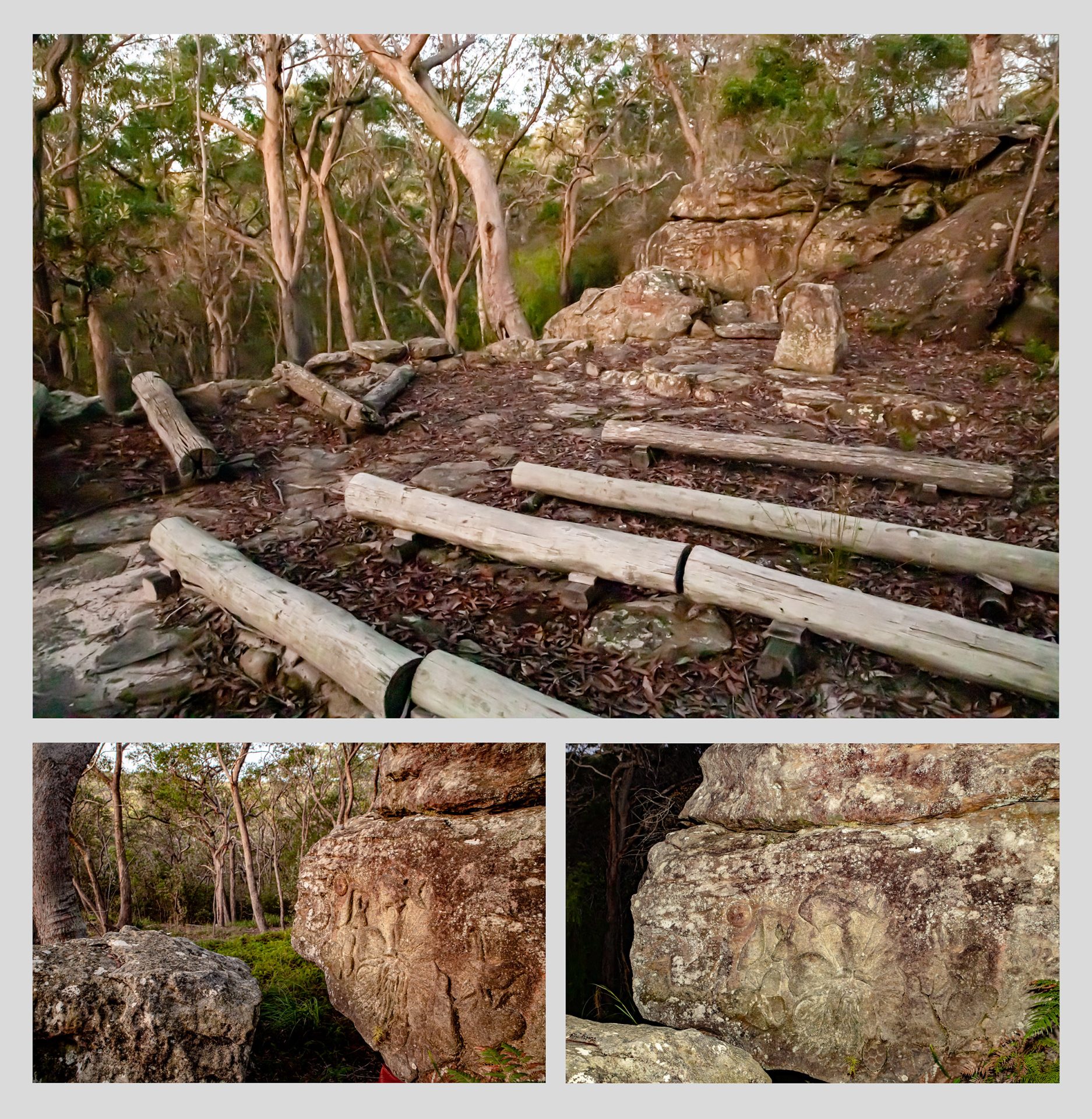
Towards the latter part of his life, Mick was interviewed a few times by community media, to which he revealed he was the infamous Phantom Carver, often revered but rarely identified in the 1970s, 80s and 90s.
Mick passed at the age of 94 in August 2022, but his son Chris has many amusing anecdotes about his eccentric genius father, both of whom shared a love of fishing.
Indeed, it was during many of these seafront excursions that Mick would leave Chris in charge of the rods while he selected a nearby rock to leave an impression.
“Whenever we went fishing, he’d take a hammer and chisel with him,” Chris recalled.
“Whenever we went fishing, he’d take a hammer and chisel with him”
“Everywhere we went! We’d fish for an hour or two and then I’d keep fishing while he’d find a rock and start chipping away! Usually little Aboriginal faces. Sometimes bigger ones, it just depended on how much time he had and what sort of rock it was.
“I still see them occasionally. You’d be surprised where they are. They pop up out in the middle of nowhere. I fish all over the place – I’m a mad rock fisherman! – and I’ll just be standing on a rock and look up and see one of his faces!”
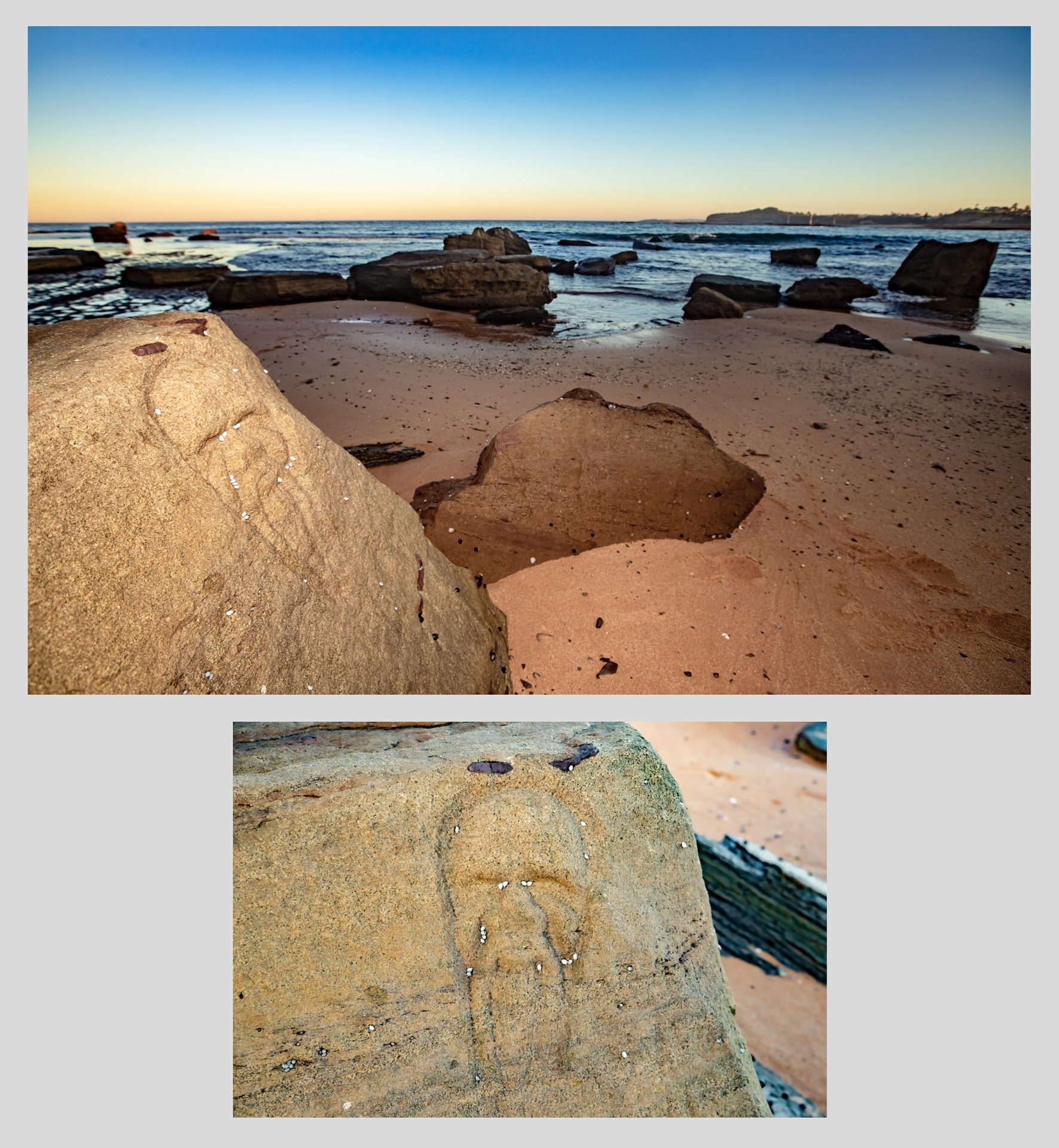
Origin of the epithet
Chris revealed to me that his father borrowed his moonlighting moniker from a Marvel Comics cartoon character, The Phantom, and initially signed his works with the Phantom face. That was until Marvel’s legal representatives came knocking.
“He was not thinking, just being a silly old man,” Chris revealed.
“We were living in Lagoon Street [Narrabeen] at that time, so it would have been in the 1970s. Two guys in suits turned up from Marvel Comics and said, ‘We’re gonna sue you!’ Yeah, they were serious! ‘There’s a breach of copyright!’ It meant a big deal!
“But then he had a word with them and he obviously charmed them, and afterwards they said, ‘Okay, look, we know you didn’t mean it, but cease and desist!’ That was the end of his using the logo and he sort of phased out of the Phantom Carver.
“But people already knew him as the Phantom Carver anyway.”
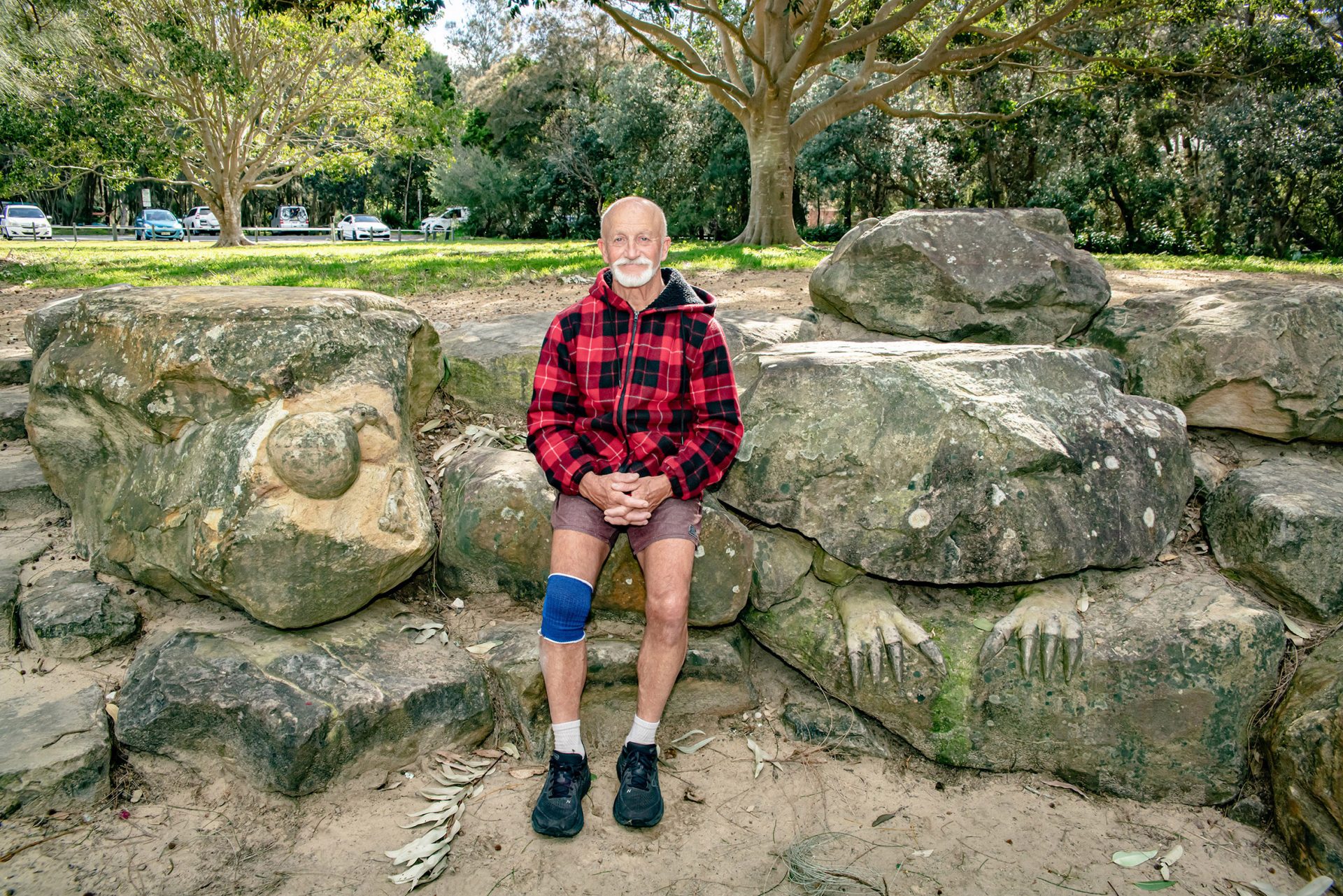
I met Chris Leslie at the Bilarong Reserve where his father’s incredible creativity shines through in the collection of sandstone statues for kids to clamber upon.
While they are all wonderful works by Newton, Mick and Chris Bennetts, ranging from native animals to dragons to sea creatures, the Confucius-like Chinese man with a bird upon his shoulder, the doorway to a mysterious underworld, and the monster’s claws emerging from a fissure in a rock are testaments to Mick’s vivid imagination.
Intrepid treks
My investigations involved several treacherous treks to remote coastal locations to find traces of Mick’s intricate artworks. Many of them are now almost indiscernible due to weathering, seawater and salt air, or obscured by lichen and foliage.
Some of these searches involved clambering across seafront rock beds below steep headlands, my feet drenched on numerous occasions as fast incoming tides tried to drag me out into the Pacific Ocean.
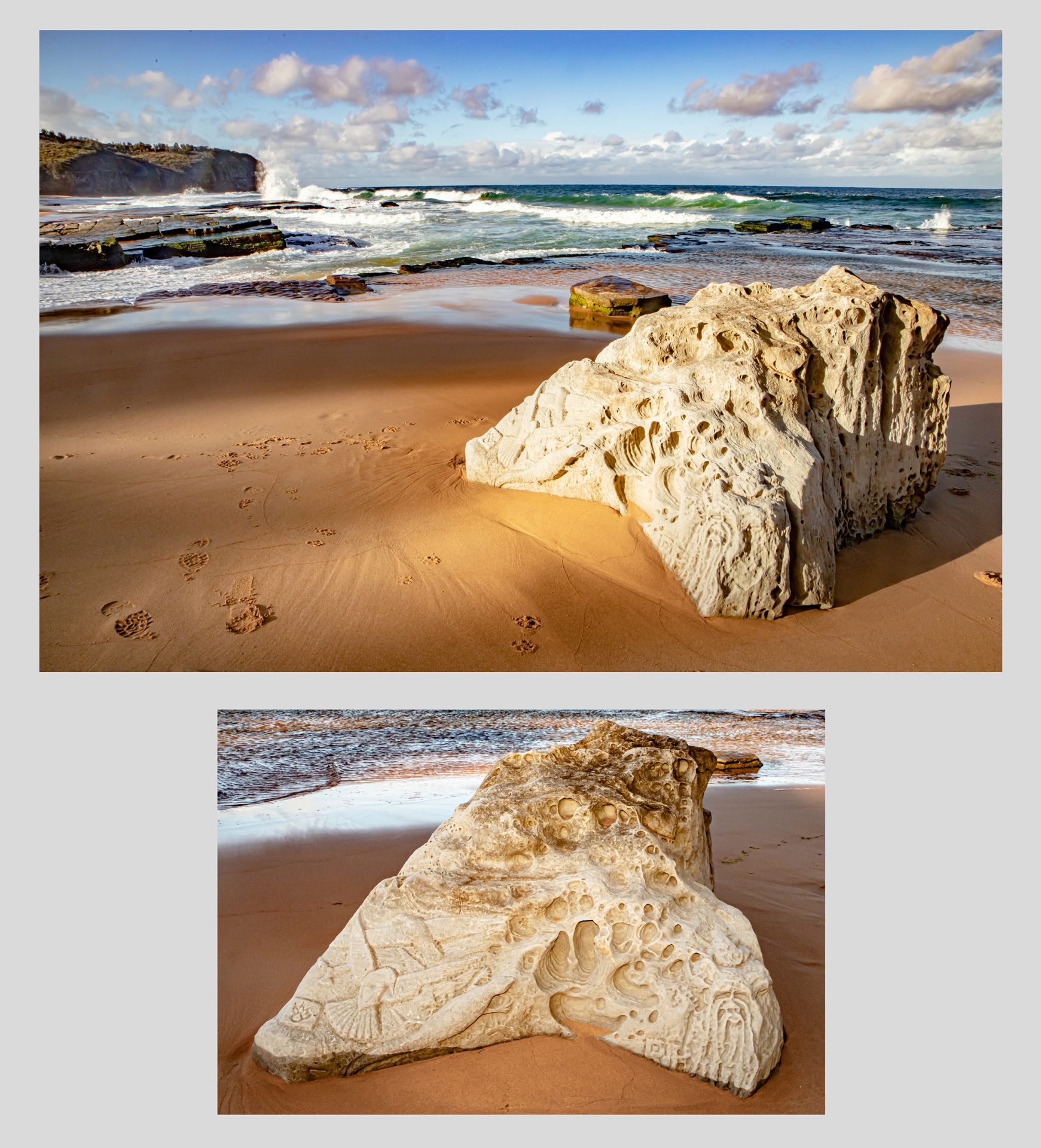
Another adventure involved following a bush trail towards a remote strip of sand below Grotto Point in Clontarf, with the foreboding name of Washaway Beach. The path began as a clearly defined track but devolved into a winding creek with water coursing over moss-coated rocks and steep clay banks – very slippery in the aftermath of a week’s torrential rain. I became disoriented.
A deaf bushwalker from whom I sought directions hand-signed the internationally-recognised motion for washing dishes (familiar to this former restaurant pot-scrubber) and I gave him a thumbs-up. Washing = Washaway (Beach).
Descending to the edge of a steep rock ledge, my arthritic knees threatened to catapult me over the precipice onto a wave-lashed strip of sand 10 metres below. I looked around in disappointment. The vista was scenic and wonderfully remote, however, the jagged rock face was absent of what I was seeking: Mick’s engaging engraving.
However, when I peeked over the edge of the ledge, a carved countenance peered back up at me! A solitary rock on the sand, about a metre high and two metres in length, features a human face chiselled into one end looking up at the ledge above.

Below, close-up of the engraving. Photos: Alec Smart
Creative carvings
Other explorations were less audacious.
A walk across the sand to see a carved rock at the southern end of Turimetta Beach, minutes before it was submerged by high tide.
A cycle down to the arrivals wharf at the Quarantine Station, where some of Mick’s engravings sit among the historic carvings on the rock face.
A motorcycle ride to south Palm Beach to see the engraved rock adjacent to the tidal pool, which is actually inverted – strong waves once picked this big boulder up and flipped it over like a burger patty.
An ascent up a steep and stony bush track at sunset to a religious altar on a hillside in the remote bushland of Ingleside Scout Camp. This spooky climb felt like a visit to a sacrificial ceremony (perhaps my own with the forest spirits), but the intricate engravings at the peak were (thankfully) benign.
A visit to a private house in Bayview where a decades-old cat cemetery, featuring Mick’s carved headstones, is hidden among foliage at the rear of their forested garden.
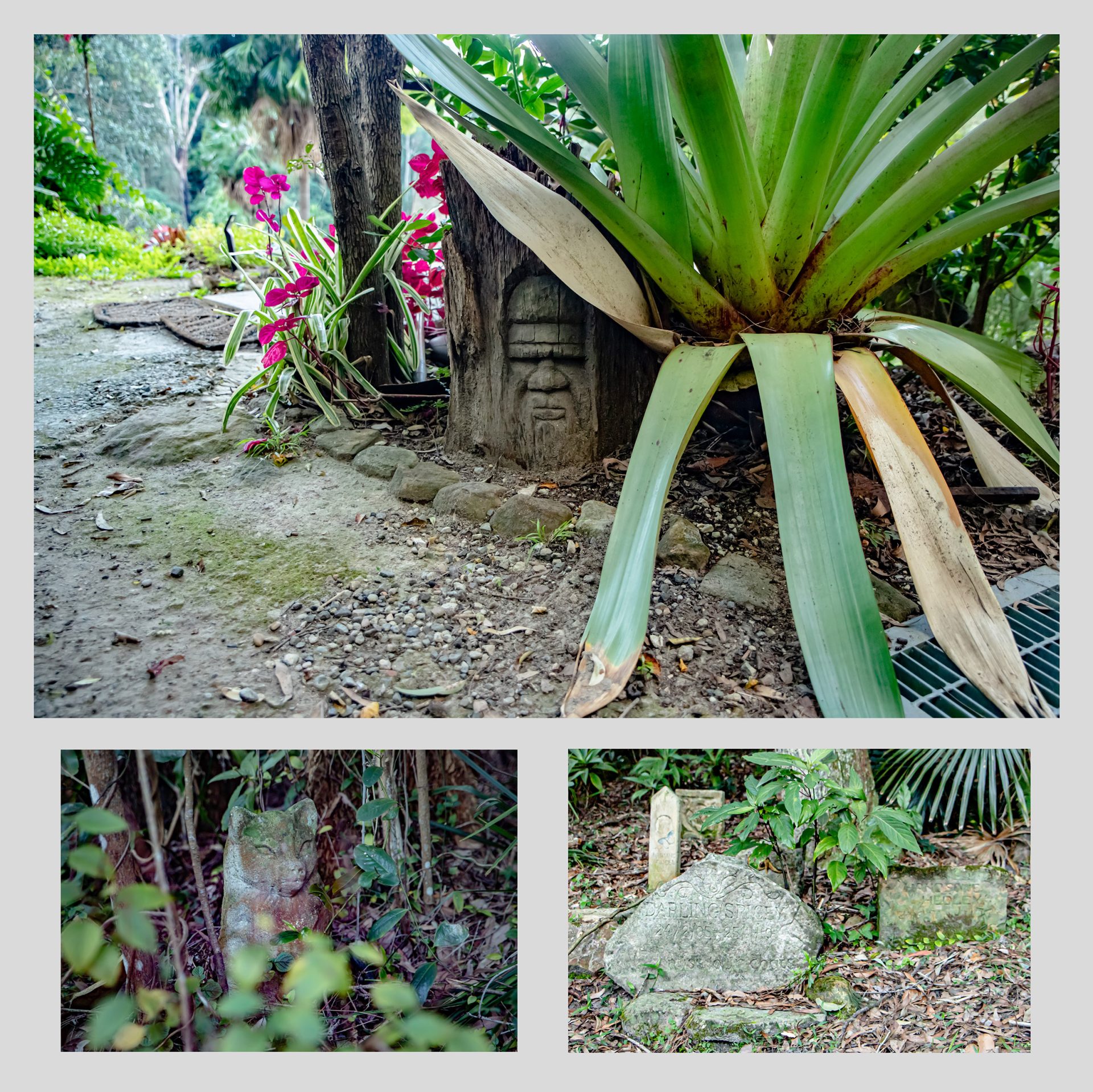
Chris Leslie reckons that despite him accompanying his father on many occasions whilst he chiselled away, there are loads of engravings of which he’s unaware.
“There’d be dozens and dozens that I don’t even know of. Because he worked for the Council for, oh, 20-odd years, I think, I reckon he would have done a carving every day!” he said.
After he reached retirement age, Mick kept creating and also undertook a few private commissions (a house in Ingleside has a garden full of Mick’s sculptures) utilising the workshop at his home in Elanora Heights. And despite his formidable talent – he was also a landscape painter – it appears Mick was not financially motivated.
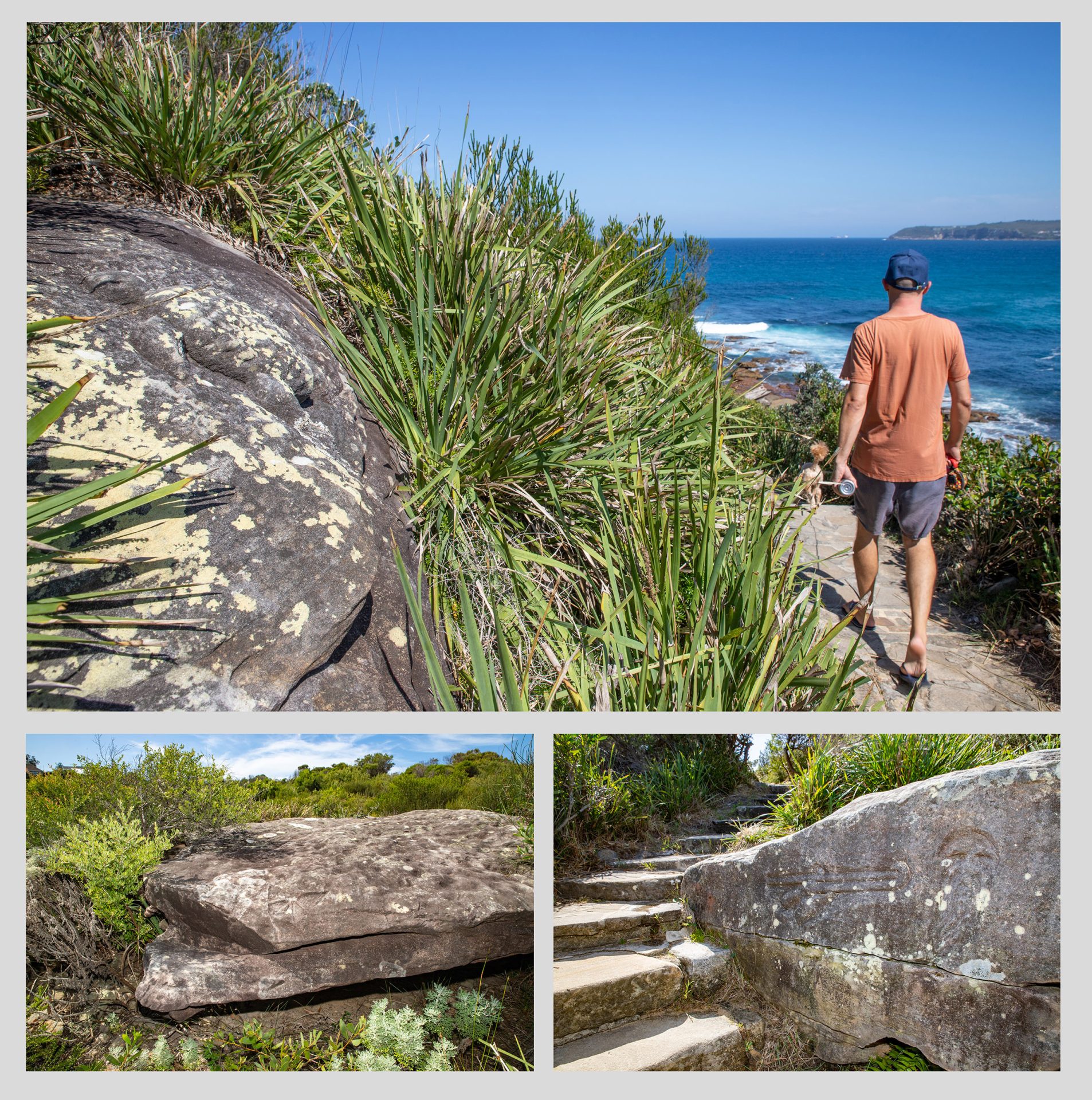
“He used to sell quite a few sculptures, but he gave a lot away,” his son, Chris, revealed.
“I looked after my dad at his house until he passed away. He made nearly 95.” (Mick’s wife passed earlier in 1998.)
“We had a long driveway up to the house. We lived in Berowra Avenue and my wife and I were in a granny flat downstairs. People would come in from walking up the street, and they’d see his work and say, ‘Oh that’s wonderful!’ Then he’d reply, ‘Where do you live, I’ll drop it off for you!’
“He’d get their address and take it up and put it in their garden for nothing! He did at least 100 of those. He was very, very generous. As I say, he’d make $20 and spend $40 – which is unusual for a Scotsman!” Chris joked.
“Well, if it wasn’t for my mum they would have never had anything, because he was hopeless, really hopeless with money. But that was him, that was his charm. He was a great father, a great father.”
